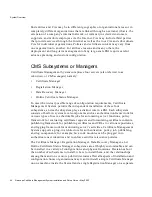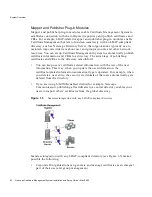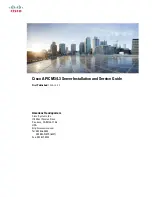
System Overview
56
Netscape Certificate Management System Installation and Setup Guide • May 2002
When you configure a Registration Manager or Certificate Manager an
authentication module, you can specify how the DN should be used to formulate
the subject name. As a result, neither the user nor the agent needs to figure out or
enter the subject name—its formulation is entirely automated.
You can also write custom authentication modules, for example to authenticate end
entities by using existing customer databases or security systems.
Tutorials and sample code provided as a part of CMS software development kit
(SDK) demonstrate how to write a custom authentication module. For details, see
section “CMS SDK” on page 65.
For information about ways customized authentication modules can be used
during enrollment, see “Some Enrollment Scenarios” on page 84.
For step-by-step instructions to configure an authentication method, see Chapter
15, “Setting Up End-User Authentication.”
Table 1-2
Authentication plug-in modules for end-user enrollments
Plug-in module name
Description
Manual authentication
Requires manual approval by an agent. This authentication module is
hardwired; you cannot configure it. This ensures that when the server
receives requests that lack authentication credentials, it sends them to the
request queue for agent approval. It also means that if you don't configure
Certificate Management System for any other authentication mechanism,
the server automatically sends all certificate-related requests to a queue
where they await agent approval.
Directory-based
authentication
Checks a user’s name and password against the user’s entry in a specified
directory and uses the DN for that entry to formulate the subject name for
the certificate.
Directory-based PIN
authentication
Checks a user’s name, password, and a special one-time PIN against the
user’s entry in a specified directory and uses the DN for that entry to
formulate the subject name for the certificate. The PIN is stored in salted
and hashed form, and is removed after being used once to authenticate a
user during enrollment.
NIS-based authentication
Authenticates end users based on their user IDs and passwords stored in a
NIS server. Optionally, uses an LDAP directory for formulating certificate
subject names.
Portal-style authentication
Checks that a user’s name is unique in an LDAP directory.
Summary of Contents for NETSCAPE DIRECTORY SERVER 6.01
Page 1: ...Installation and Setup Guide Netscape Certificate Management System Version6 01 May 2002...
Page 22: ...22 Netscape Certificate Management System Installation and Setup Guide May 2002...
Page 32: ...32 Netscape Certificate Management System Installation and Setup Guide May 2002...
Page 160: ...160 Netscape Certificate Management System Installation and Setup Guide May 2002...
Page 776: ...776 Netscape Certificate Management System Installation and Setup Guide May 2002...
Page 807: ...807 Part 5 Appendix Appendix A Certificate Download Specification...
Page 808: ...808 Netscape Certificate Management System Installation and Setup Guide May 2002...
Page 830: ...830 Netscape Certificate Management System Installation and Setup Guide May 2002...
















































